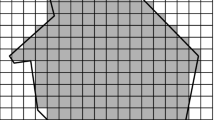Abstract
While edge detection is an important first step for many vision systems, the linked lists of edge points produced by most existing edge detectors lack the higher level of curve description needed for many visual tasks. For example, they do not specify the tangent direction or curvature of an edge or the locations of tangent discontinuities. In this paper, a method is presented for describing linked edge points at a range of scales by selecting intervals of the curve and scales of smoothing that are most likely to represent the underlying structure of the scene. This multiscale analysis of curves is complementary to any multiscale detection of the original edge points. A solution is presented for the problem of shrinkage of curves during Gaussian smoothing, which has been a significant impediment to the use of smoothing for practical curve description. The curve segmentation method is based on a measure of smoothness minimizing the third derivative of Gaussian convolution. The smoothness measure is used to identify discontinuities of curve tangents simultaneously with selecting the appropriate scale of smoothing. The averaging of point locations during smoothing provides for accurate subpixel curve localization. This curve-description method can be implemented efficiently and should prove practical for a wide range of applications including correspondence matching, perceptual grouping, and model-based recognition.
Similar content being viewed by others
References
Haruo Asada and Michael Brady, “The curvature primal sketch,” IEEE Trans. PAMI 8(1):2–14, 1986.
D.H. Ballard, “Strip trees: A heirarchical representation for curves,” Comm. ACM 24(5):310–321, 1981.
Thomas O. Binford, “Inferring surfaces from images,” Artificial Intelligence 17:205–244, 1981.
R.C. Bolles, P. Horaud, and M.J. Hannah, “3DPO: A three-dimensional part orientation system,” Proc. 8th Intern. Joint Conf. Artif. Intelli., Karlsruhe, West Germany, pp. 1116–1120, 1983.
John Canny, “A computational approach to edge detection,” IEEE Trans. PAMI 8(6):679–698, 1986.
B.K.P. Horn, and E.J. Weldon, “Filtering closed curves,” IEEE Trans. PAMI 8(5):665–668, 1986.
David G. Lowe, and Thomas O. Binford, “Perceptual organization as a basis for visual recognition, Proc. 3rd Nat. Conf. Artif. Intell., pp. 255–260, August 1983.
David G. Lowe, Perceptual Organization and Visual Recognition. Kluwer Academic: Boston, 1985.
David G. Lowe, “Three-dimensional object recognition from single two-dimensional images,” Artificial Intelligence 31(3):355–395, 1987.
A.K. Mackworth, and F. Mokhtarian, “Scale-based description of planar curves,” Proc. 5th Canadian Soc. Comp. Studies Intell. London, Ontario 114–119, May 1984.
A.K. Mackworth, and F. Mokhtarian, “The renormalized curvature scale space and the evolution properties of planar curves,” Proc. IEEE Conf. Comput. Vision Pattern Recognition, Ann Arbor, June 1988.
David H. Marimont, “A representation for image curves,” Proc. 4th Nat. Conf. Artif. Intell. Austin, Texas, pp. 237–242. August 1984.
David Marr, and Ellen Hildreth, “Theory of edge detection,” Proc. Roy. Soc. (London) B 207:187–217, 1980.
F. Mokhtarian, and A.K. Mackworth, “Scale-based description and recognition of planar curves and two-dimensional shapes,” IEEE Trans. PAMI 8(1):34–43, 1986.
Pierre Parent, and Steven W. Zucker. “Trace inference, curvature consistency, and curve detection,” Tech. Rep. CIM-86-3. Computer Vision and Robotics Lab. McGill University, 1985.
T. Pavlidis, Structural Pattern Recognition. Springer-Verlag: New York, 1977.
A.P. Pridmore, J. Porrill, and J.E.W. Mayhew, “Segmentation and description of binocularly viewed contours,” Image and Vision Computing 5(2):132–138, 1987.
L.G. Roberts, “Machine perception of three-dimensional solids.” In Optical and Electro-optical Information Processing, J. Tippet (ed.) MIT Press: Cambridge, MA, 159–197, 1966.
Yoshiaki Shirai, “Edge finding, segmentation of edges and recognition of complex objects,” Proc. Intern. Joint Conf. Artif. Intell. 75:674–681, 1985.
Andrew P. Witkin, and Jay M. Tenerbaum, “On the role of structure in vision.” In Human and Machine Vision, J. Beck et al. (eds.) Academic Press: New York, 481–543, 1983.
Andrew P. Witkin, “Scale-space filtering,” Proc. 8th Intern. Joint Conf. Artif. Intell., Karlsruhe, West Germany, pp. 1019–1022, August 1983.
Steven W. Zucker, Chantal David, Allan Dobbins, and Lee Iverson, “The organization of curve detection: Course tangent fields and fine spline coverings,” Proc. 2nd Intern. Conf. Computer Vision pp. 568–577, Tampa, Florida, Dec. 1988.
Author information
Authors and Affiliations
Rights and permissions
About this article
Cite this article
Lowe, D.G. Organization of smooth image curves at multiple scales. Int J Comput Vision 3, 119–130 (1989). https://doi.org/10.1007/BF00126428
Issue Date:
DOI: https://doi.org/10.1007/BF00126428




